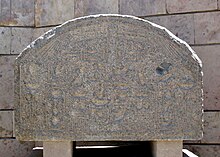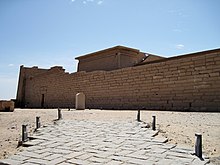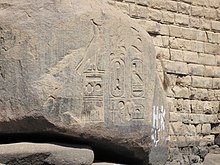Schellal stele
The Schellal stele , also from Shellal , is an ancient Egyptian stele made of rose granite with a hieroglyphic inscription that goes back to Psammetich II , the third king ( Pharaoh ) of the 26th dynasty . It comes from a quarry area south of Aswan near the end point of the railway line, which is now flooded by Lake Nasser , from where the steamboats to Wadi Halfa set off on the Nile . The stele found west of the Nile in 1964 is now placed on the north side of the Mandulis Temple, which was moved to the island of Neu-Kalabsha in Lake Nasser .
description
Even Richard Lepsius had the upper part of a stela, attached to a small temple near Philae , on the Royal Prussian expedition to Egypt and Ethiopia from 1842 signed up in 1845, in Book VIII of the panel work of the monuments of Egypt and Ethiopia released. The hieroglyphic inscription on this fragment of the stele is almost identical to that on the upper part of the Schellal stele discovered in 1964. In the 8 columns of both inscriptions the cartouches of the king with his throne name Nefer-ib-Re (Nfr-jb-Rˁ) and his proper name Psammetich (Psmṯk) are listed in columns 2 and 7. The translation of the upper part of the Schellal stele from left to right is:
(original in the Nubian Museum and drawing by Richard Lepsius )
Loved by Wadjet , who grants life, health and reign. King of Upper and Lower Egypt, Nefer-ib-Re, may he live forever. Horus Menech-ib-Re who gives life. Loved by Satis , the mistress of Elephantine . Loved by Khnum , Lord of the Cataract . Horus Menech-ib-Re who gives life. Son of Re, Psammetich, may he live forever. Loved by Nechbet , who grants life, health and dominion.
The rest of the text on the Schellal stele describes the last military advance of an ancient Egyptian king to the south. In contrast to the other two text documents that describe Psammetich's II campaign to Nubia , the Karnak and Tanis stelae, the inscription on the Schellal stele has been preserved in full. The lack of determinatives creates a large scope for translation. The inscription is divided into 12 columns that can be read from right to left. Right at the beginning of the text, the third year of the king's reign is given as the date of the campaign, which, according to today's view, was the year 593 BC. Chr. Would correspond. The former southern border of the Pharaonic Empire against the Empire of Kush is assumed to be the installation site .
In the first of the 12 columns on the tenth day of the second month of the season is Schemu (SMW) in the third year of the reign of Psammetichus II called., According to the dating of the lunar calendar of 17 or 18 October 593 v. While the first two columns again describe the king as loved by the gods, the third and fourth columns indicate that Psammetich was traveling within Upper and Lower Egypt ( ww = f - in his two countries), that were flooded by the Nile ( bˁḥ = f - in his flooded land) when, according to the 5th column, a messenger came to him. The messenger reported in the 6th and 7th column that the troops of Pharaoh that this in the arc country sent (Nubia), the foreign country of Pnubs ( Kerma ) have reached. There all the Nubians rose up against Psammetich's armed forces, which, however, found an unsuitable battlefield, unsuitable for horses.
The 8th column begins with the king's decision to lead his troops in Nubia himself. It is described how the rebels turned to flee after the arrival of Psammetich, without facing the fight, without raising their weapons against the king. According to columns 9 and 10, 4,200 of the Nubians were captured. After the happy outcome of the fight, Psammetich had a large number of short and longhorn cattle sacrificed to the gods of Upper and Lower Egypt, one of the gods of the bodyguard of the palace, in order, as the 12th column indicates, all stability, power, health and happiness forever to secure.
From the content of the stele inscription it is not clear who led the Nubians against Psammetich II, possibly Aspelta or his predecessor as king of the Kushitic empire Anlamani . From the end of the 25th Dynasty , the Cushite rule over Egypt to their last Pharaoh Tanotamun , who ruled from 664 to 657 BC. Ruled, there was no serious conflict between Egypt and Cush. The fragment of the Tanis stele cites the reason for Psammetich II's military action to have anticipated a planned attack by the Nubians. Psammetich's troops included numerous mercenaries from the eastern Mediterranean , such as Greek Ionians and Dorians as well as Carians , Phoenicians and Judeans , who left several graffiti on the outer facade of the temple of Abu Simbel during the campaign .
After the military decision in favor of the Egyptians near the third cataract near Kerma, Psammetich II began the return journey. His forces advanced further south, where, according to the Tanis stele , they conquered and destroyed the royal capital of the Kushite Empire, which in all probability was Napata . The names of the commanders of the Egyptian troops are known from a Greek inscription on the colossal seated figure of Ramses II south of the entrance to the rock temple at Abu Simbel. The native Egyptians commanded Amasis , who later became Pharaoh himself, the foreign-language mercenaries Potasimto . The campaign ended on the fourth cataract, which was impassable for ships. It remains unclear why, after the end of the fighting, Nubia was not incorporated into the Egyptian Empire, but why the southern border of Egypt continued to run along the first cataract south of Elephantine Island near the temple of Philae .
literature
- Joachim Willeitner : Abu Simbel and the temples of Lake Nasser. The archaeological guide . von Zabern , Darmstadt, Mainz 2012, ISBN 978-3-8053-4457-9 , Die Schellal-Stele , p. 35–37 ( digitized version of the table of contents [PDF]).
Web links
- Stela of Psammetich II from Year 3 of his Nubian campaign, from Shellal (near Aswan). 593 BC transcription and English translation
Individual evidence
- ^ Richard A. Lobban Jr .: Historical Dictionary of Ancient and Medieval Nubia . Scarecrow Press, Lanham 2003, ISBN 978-0-8108-6578-5 , pp. 367 (English, limited preview in Google Book search).
- ↑ Walter Wreszinski ( edit .): Richard Lepsius : Monuments from Egypt and Ethiopia. Table works, Volume VIII: New Kingdom. Hinrichs, Leipzig 1913, p. 274d ( digitized version of the Lepsius project Saxony-Anhalt).
- ^ Joachim Willeitner : Abu Simbel and the temples of Lake Nasser. The archaeological guide . von Zabern , Darmstadt, Mainz 2012, ISBN 978-3-8053-4457-9 , Die Schellal-Stele, p. 37 .
- ↑ Francis Breyer : Psammetics II., The old warrior - on a military-language phrase in the Shellal inscription . In: Hartwig Altenmüller, Nicole Kloth (ed.): Studies on ancient Egyptian culture . tape 30 . Buske , Hamburg 2002, ISBN 978-3-87548-330-7 , p. 53 , JSTOR : 25152859 .
- ↑ Stela of Psammetich II from Year 3 of his Nubian campaign, from Shellal (near Aswan). 593 BC . In: Tormod Eide, Tomas Hägg, Richard Holton Pierce, László Török (eds.): Fontes Historiae Nubiorum . tape 1 . University of Bergen, Bergen 1994, ISBN 82-991411-6-8 , p. 282 ( digital version [PDF; 3.8 MB ; accessed on August 25, 2015]).
- ↑ a b c d Joachim Willeitner : Abu Simbel and the temples of Lake Nasser. The archaeological guide . von Zabern, Darmstadt, Mainz 2012, ISBN 978-3-8053-4457-9 , Die Schellal-Stele, p. 36 .
- ^ Alfred Wiedemann : The Greek inscription from Abu-Simbel (= Rheinisches Museum für Philologie ). Sauerländer , Frankfurt am Main 1880, p. 364–372 ( digitized version [PDF; 2.0 MB ; accessed on August 25, 2015]).
- ↑ Peter W. Haider: Greeks in the Middle East and in Egypt . In: Christoph Ulf (Hrsg.): Paths to the genesis of Greek identity: The meaning of the early archaic time . Academy , Berlin 1996, ISBN 3-05-002899-8 , pp. 106–107 ( limited preview in Google Book search).
Coordinates: 23 ° 57 '39.9 " N , 32 ° 52' 2.7" E





